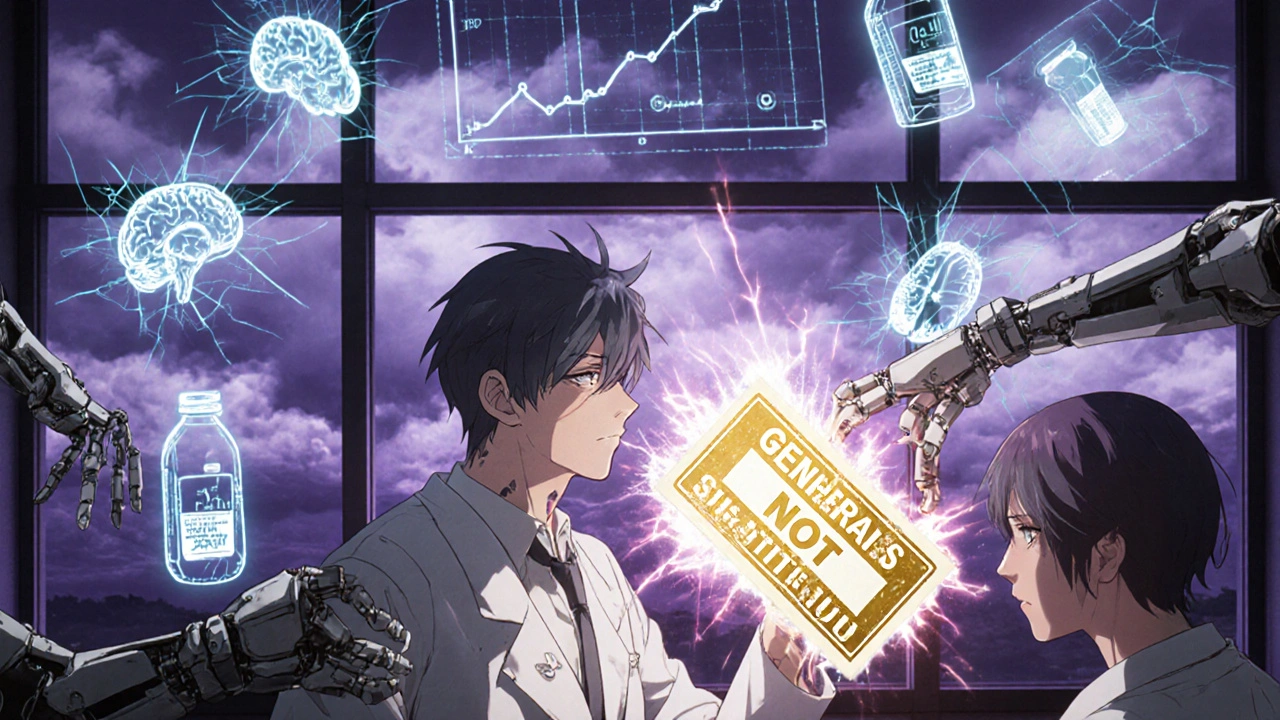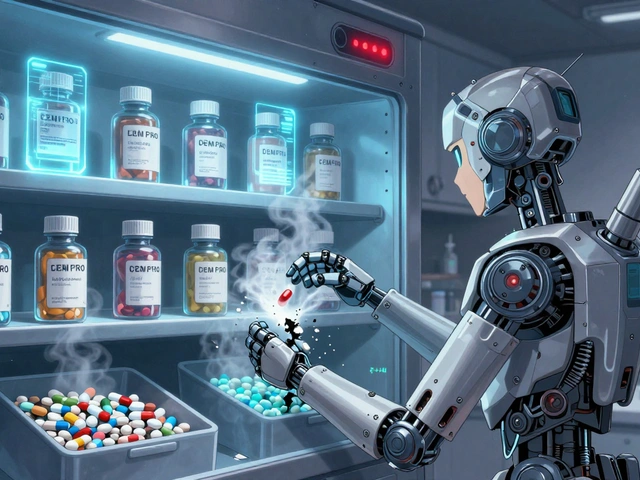When a pharmacist swaps a brand-name drug for a generic, most people assume it’s just a cost-saving move with no real impact. But for NTI drugs-narrow therapeutic index medications-that assumption can be dangerous. These are drugs where even a tiny change in dose or blood level can mean the difference between healing and harm. Think warfarin, lithium, phenytoin, levothyroxine, or tacrolimus. A 5% shift in concentration might cause a seizure, a blood clot, or organ rejection. And yet, substitution practices vary wildly across the U.S., depending on who’s prescribing, who’s dispensing, and which state you live in.
What Makes a Drug an NTI Drug?
Not all drugs are created equal. The FDA defines an NTI drug as one where the gap between the minimum effective dose and the minimum toxic dose is very small-usually a ratio of 2:1 or less. That means if your blood level of the drug drops just a little, it won’t work. If it rises a little, you could get seriously sick. This isn’t theoretical. In 2019, the FDA tightened bioequivalence standards for generics of these drugs from the usual 80-125% range to 90-111%. That’s a big deal. It means the generic must be almost identical in how it’s absorbed and used by the body.
But even with those tighter rules, many doctors still don’t trust generics for NTI drugs. Why? Because they’ve seen what happens when a patient switches. One patient on warfarin for years, stable at an INR of 2.5, gets a generic swap. A week later, their INR spikes to 4.8. They end up in the ER with bleeding. Another patient on tacrolimus after a kidney transplant gets switched, and their drug level drops. The transplant starts to fail. These aren’t rare cases. The Institute for Safe Medication Practices logged over 1,200 NTI-related errors between 2015 and 2020, with 37% tied to substitution.
Doctors Are Divided-And It’s Not Just About Cost
It’s easy to assume doctors resist generic substitution because they’re out of touch or paid by pharma. But the truth is more nuanced. A 2018 survey of pharmacists found that 87% believed physicians thought generics were just as effective as brand-name NTI drugs. Yet, only 60% of pharmacists substituted generics for refills, even though they did so for initial prescriptions 82% of the time. That gap tells you something: doctors are fine with switching at the start, but they’re terrified of changing a stable regimen.
Transplant specialists are the most skeptical. A 1997 survey of 59 transplant pharmacists showed 92% believed bioequivalence testing should be done in actual patients-not healthy volunteers-as the FDA currently requires. Only 12% thought the current standards were good enough. That’s not paranoia. It’s experience. Transplant patients live on the edge of rejection. One milligram too little of tacrolimus, and the body attacks the new organ. One milligram too much, and the kidneys shut down.
Neurologists and psychiatrists feel the same way. The American Academy of Neurology says automatic substitution for levothyroxine, phenytoin, and warfarin is inappropriate without prescriber input. Psychiatrists managing lithium know that even a 0.2 mEq/L change can turn a calm patient into someone needing emergency care. A 2021 study found psychiatrists get an average of 5.4 substitution notifications per month-far more than primary care doctors. That’s not just paperwork. It’s anxiety.
State Laws Are a Patchwork-And They Matter
There’s no national rule on NTI substitution. Instead, you’ve got 28 states with their own rules as of 2023. Some require prescriber consent before substitution. Others demand that pharmacists notify the doctor. A few, like Texas and Florida, maintain official lists of NTI drugs that can’t be swapped without explicit permission.
And it works. States with “affirmative patient consent” laws-meaning the patient must agree to the switch-had 23% lower generic substitution rates than states without those rules. That’s not because patients are refusing. It’s because pharmacists are hesitant to push it when the law puts the burden on them. Meanwhile, the Academy of Managed Care Pharmacy opposes laws that restrict substitution, arguing pharmacists should use professional judgment. The American Society of Health-System Pharmacists, on the other hand, says pharmacists should always notify prescribers-and 78% of hospital pharmacists say they do.
The disconnect? Pharmacists want to save money and streamline care. Doctors want to avoid risk. Neither side is wrong. But without clear communication, the patient pays the price.

Doctors Are Hearing From Patients-And It’s Messy
It’s not just the labs that tell doctors something’s off. Patients are calling. The AMA reports that 41% of physicians have seen patients confused after an NTI switch. One patient thinks, “I got the same pill, why do I feel awful?” Another panics because the pill looks different. They show up at the office, ask for the old brand, or stop taking it altogether.
Those visits cost money. The Medical Group Management Association estimates each NTI substitution-related office visit costs $127. That’s not just time-it’s lab tests, extra monitoring, maybe even ER visits. And it’s all preventable.
Doctors are asking for better tools. Dr. Michael Cohen of ISMP says prescribers need clearer labeling on NTI drugs and standardized communication when substitutions happen. Right now, a pharmacist might call, email, or just log it in the system. No consistency. No clarity. No accountability.
What’s Changing-and What’s Not
The FDA says 98% of generics, including NTI drugs, perform within 3-4% of their brand-name counterparts. That’s backed by post-market data. But data doesn’t always match lived experience. In 2023, Medicare Part D data showed brand-name NTI drugs still held 23% of the market-compared to just 8% for non-NTI drugs. Tacrolimus? 32% brand share. Warfarin? 28%. Levothyroxine? 25%. That’s not because patients demand it. It’s because doctors are writing prescriptions that say “dispense as written” or “no substitution.”
A 2023 survey by the American College of Physicians found 57% of internists would prescribe brand-name NTI drugs for high-risk patients. Why? Stability. They’ve seen what happens when the drug changes. They don’t want to gamble with someone’s life.
But change is coming. The FDA added 12 new drugs to its NTI list in March 2023 and removed three. The Centers for Medicare & Medicaid Services proposed a rule in November 2023 requiring prescriber notification for all NTI substitutions under Medicare Part D. That’s a big step toward standardization.
Meanwhile, research is underway. The PRESCRIPT-NTI trial, enrolling 1,200 patients across 42 sites, is tracking outcomes after substitution. Preliminary results are due in mid-2024. If the data shows no increase in adverse events, it could shift attitudes. But if it confirms what doctors already suspect-that stability matters more than savings-it could lock in stricter rules for years to come.

What Should Prescribers Do?
If you’re prescribing an NTI drug, here’s what actually works:
- Write “Dispense as Written” or “Do Not Substitute” if you’re unsure. Don’t assume the pharmacist knows your concern.
- Use electronic prescribing systems that flag NTI drugs. Many EHRs now have built-in alerts.
- Ask your pharmacist: “Will you notify me if you switch this?” Most will say yes-but don’t assume.
- For high-risk patients (transplant, epilepsy, heart failure, bipolar disorder), consider starting with the brand. If the patient is stable, stick with it.
- Document your reasoning. If a patient has a bad reaction after a switch, your notes could mean the difference between blame and understanding.
It’s not about distrust in generics. It’s about respecting how little margin for error these drugs have. A pill might look the same. But in the body, it’s not always the same.
What Should Pharmacists Do?
Pharmacists are on the front lines. You’re the ones catching errors, answering questions, and managing the system. Here’s how to bridge the gap:
- Always notify the prescriber before substituting an NTI drug-even if your state doesn’t require it.
- Use electronic notifications. Most doctors prefer them over phone calls.
- Keep a list of NTI drugs your pharmacy handles. Know which ones are flagged by the FDA and which states restrict them.
- Educate patients: “This is a sensitive medication. Even small changes can affect how it works. Let your doctor know if you notice anything different.”
- Don’t assume the patient knows the difference between brand and generic. Many don’t.
The goal isn’t to stop substitution. It’s to make it safe. And safety means communication, consistency, and caution.
Where Do We Go From Here?
NTI drugs are a perfect example of how healthcare isn’t just about science-it’s about systems, communication, and trust. The FDA says generics are safe. Doctors say, “Show me.” Patients say, “I just want to feel okay.” Pharmacists say, “I want to help.”
The answer isn’t to ban generics. It’s to build better bridges between everyone involved. Clear labeling. Standardized notifications. Electronic alerts. Prescriber education. Patient counseling.
Because when you’re managing a drug where a milligram can change everything, the last thing you need is confusion.







Ginger Henderson
November 26, 2025 AT 23:19Okay but like... why are we acting like generics are some kind of evil villain? I’ve been on generic levothyroxine for 8 years and my thyroid is more chill than my ex’s new boyfriend. Doctors freak out like it’s a nuclear launch code.
Bethany Buckley
November 28, 2025 AT 22:53The ontological insecurity of pharmacoeconomic reductionism manifests in the clinical sphere as a pathological aversion to epistemic uncertainty-particularly when the therapeutic window is narrower than the interpretive gap between FDA bioequivalence metrics and lived physiological phenomenology. In other words: we’re treating molecules like they’re souls, and that’s not science-it’s superstition with a stethoscope. 🧠💊
Gina Banh
November 29, 2025 AT 07:33Stop romanticizing the brand-name placebo effect. If a patient’s INR spikes after a switch, it’s not because the generic is ‘different’-it’s because the pharmacist didn’t document the change, the EHR didn’t alert the doctor, and the patient didn’t know to call. This isn’t about drug quality. It’s about broken systems. Fix the workflow, not the prescription. And stop letting fear drive clinical decisions. We’re not running a cult of stability-we’re running a medical system.
Deirdre Wilson
November 30, 2025 AT 19:11I had a friend on warfarin who switched generics and started feeling like a zombie. She thought she was dying. Turned out she just didn’t know the pill looked different. No one told her. No one warned her. It’s wild how something so tiny-like the color of a pill-can make someone feel like the whole world’s falling apart. We need to talk to people like they’re humans, not data points.
Damon Stangherlin
December 1, 2025 AT 22:40Hey all-just wanted to say this is such an important convo. I’m a med student and I’ve seen this play out in clinics. Doctors are scared, pharmacists are overloaded, patients are confused. But it’s fixable. We just need better tech, better training, and less blame. Everyone’s trying to do the right thing. Let’s make it easier for them. 🙏
stephen riyo
December 2, 2025 AT 08:28Wait... so you're saying... that doctors... are scared... of... generics... because... they... saw... one... bad... case... and now... they... think... every... generic... is... a... ticking... time... bomb...?... I... mean... really...?... Like... what... if... we... just...... tested... everyone...?... Like... blood... draws...?... Every... month...?... That's... not... hard... right...?...?
Wendy Edwards
December 3, 2025 AT 11:54My dad’s on tacrolimus after his transplant. They switched him to generic once. He got so sick they had to rush him back to the hospital. He cried in the ER because he thought he was going to lose his new kidney. Don’t tell me this isn’t real. Don’t tell me it’s ‘just paperwork.’ This is someone’s life. And yeah-I’m mad. And yeah-I want better.
Jaspreet Kaur
December 3, 2025 AT 23:58Life is a balance of risk and trust. We trust our cars to not break down. We trust our food to not poison us. Why not trust a pill that’s been tested 1000 times? But maybe the problem isn’t the pill. Maybe it’s the noise. The fear. The lack of quiet conversations between the doctor, the pharmacist, and the person who takes it. Slow down. Talk. Listen. The science is already there. We just forgot how to be human with it